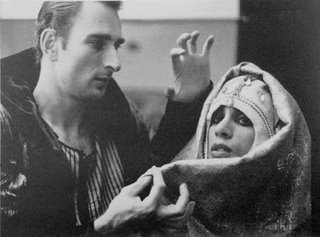Abnormal Love

The Los Angeles Premier of Jack Smith and the Destruction of Atlantis. There's a long(ish) line of mostly forty-something white folks in colorful clothing. Things are starting late. 'Technical difficulties,' we are informed. We bide our time. Tap our feet. Divulge in gossip. The Indian, college-aged student behind me (UCLA Theater?) says to his friend, 'we don't fit in here.' Some more time passes. 'Maybe,' he muses, 'maybe this is the movie.' Indeed.
Smith is a bizarre character. That goes without saying. He lived his art in the way that few people could ever dream. His apartment was Atlantis, every wall a glowing hue and every inch draped in veils. He put on plays there. A play might have been promised at midnight, but would be staved off until 3am. People would certainly have walked out. Smith called them the scum of Baghdad. Eventually, the play would begin. As did the film, though our circumstances would have pleased Smith. As it was, we only waited for an extra half hour, so we kind of earned our show.
 Jack Smith and the Destruction of Atlantis is a very good documentary. I'll say that up front. It has a consistency and narrative flow which is greatly admirable, particularly considering the material. And that is its strong point. Its success lies in its use of the source material. On its countless clips of Smith... well, doing his thing. Smith was a magnificent performer, an artist, a photographer, a filmmaker, an actor, an escapist, an idealist, an anti-Capitalist... but his contributions (assuredly painstaking for director Mary Jordan) were all left (intentionally) unfinished. Smith loathed "products." They were the ideal of Capitalism, or, in Smithian terms: Landlordism, lobsterism. Flaming Creatures is his only finished film, and of course, a print of wonderful quality is present here.
Jack Smith and the Destruction of Atlantis is a very good documentary. I'll say that up front. It has a consistency and narrative flow which is greatly admirable, particularly considering the material. And that is its strong point. Its success lies in its use of the source material. On its countless clips of Smith... well, doing his thing. Smith was a magnificent performer, an artist, a photographer, a filmmaker, an actor, an escapist, an idealist, an anti-Capitalist... but his contributions (assuredly painstaking for director Mary Jordan) were all left (intentionally) unfinished. Smith loathed "products." They were the ideal of Capitalism, or, in Smithian terms: Landlordism, lobsterism. Flaming Creatures is his only finished film, and of course, a print of wonderful quality is present here.
The talking heads of the film are a veritable who's who of the New York art/film scene, then and now. Jonas Mekas, Ken Jacobs, Holly Woodlawn, Nayland Blake, Mike Kelly, Robert Wilson, John Zorn, Gary Indiana, Taylor Mead (in his infamously squalid apartment), (an unusually bland) John Waters make up just a few names on the list of gabbers. It is in these scenes where Jordan's hand is most obviously felt. The camera attempts to imitate Smith's. No dice. Smith was a master at what he does. Jordan's flailing DV cam is cute, but not effective in the way she desired. But we can forgive her. I've been researching Smith for the past 4 or 5 odd years now, and most of what I learned she packs into a trim 94 minutes. Mostly avoiding typical Doco structure, the opening sequence is so beautifully assembled, I would almost dare call it a video piece in its own right. The computer animated title effects work wonderfully, in all of their art deco glory. Sontag would have been proud.
Jordan joined us after the film for a Q and A. There's a visual biography in the works. The estate is on ransom. Someone asked if you could rent the films. No, dear. But this is why Jordan made the picture. So you could see them (albeit, fractured). I'd say that's as good a reason as any.

3 Comments:
The main problem with this film is that is was madeand financed by kids with million dollar trust funds. Get rid of your trust funds before you start promoting anti-capitalism to art world posers.
In all fairness, Mary Jordan met a colleague of Smith's/discovered Smith for herself on a commune in San Francisco - whether or not she's a trustafarian, I do not know....
The film is not meant to promote anti-capitalism or to push any political agenda.
It's merely a portrait of one of the great artists of the 20th century, and it was made largely because he is unknown to most people. So it's just meant to promote Jack Smith himself.
Post a Comment
<< Home